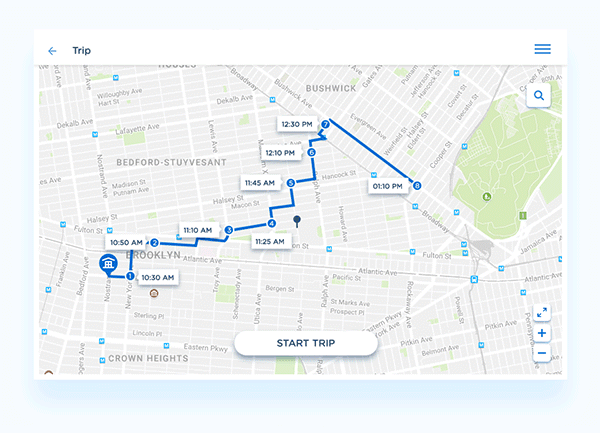Boosting Efficiency and Reducing Costs with Route Optimization
Effective route optimization is how most companies would better their logistics movement in the current business environment and in the near future. Here’s why route optimization is beneficial for a company.
Optimization is doing more with less while sustaining (or bettering) the efficiency of operations. With multiple orders and shipments constantly moving with an excess of customer requests and demand, fulfilling on-time deliveries consistently not only saves costs but also increases the overall brand value for the company. Optimizing the routes for a trip helps companies reduce the overall distance traveled, the time taken, and the cost of movement (fuel and resource/vehicle cost). It also helps in increasing the overall number of orders fulfilled in a single trip while decreasing the turnaround time. Let’s look at all these aspects in a bit more detail to understand how route optimization can better last mile delivery.
Schedule Planning
Customers have caught on with preferred-slot deliveries. Even retailers and distributors insist on deliveries in a preferred slot which helps them better manage their stocks. Customers now have the option of next-day or same-day deliveries. All these factors are considered while creating an optimized schedule plan for last mile delivery.
If a delivery is set in a specific location at a specific time (and there are multiple such specified time slots for deliveries), then the schedule must be planned along with a route which best fulfills all these service level agreements (SLAs). An optimized route plan would ensure that all these deliveries are made on time with minimal-to-no delay.
LogiNext’s billion location data points ensure that all addresses utilized within the system are accurate. This would negate the time previously taken to search for erroneous addresses while calling the receiver for confirmation. The time-cost and branding-cost benefit here is immense.
Automated Allocation

Within the resources, there would be delivery personnel who are more attuned to a territory than others. Their local knowledge can be leveraged by auto-assigning the orders in their preferred territory to them. This can be done by geocoding territories. Geocoding is a form of virtual mapping of areas (geofences) within the system. Delivery personnel can then be assigned to these geofences. Now the deliveries within this geofence would be auto-assigned to the appropriate delivery personnel based on their availability, capacity, proximity, and feasibility (of fulfilling the delivery on-time).
Such geofences help in understanding the demand coming in from territories. Using elastic clustering of demand, the manager can effectively forecast trends and allocate substantial resources (delivery personnel and vehicles) to the high-performing areas. This would help in balancing spikes of activity and minimize any delayed or failed deliveries.
The manager can also use the ‘Suggest Route’ feature for more control over the allocation of orders. Here the manager can assign ad-hoc or random orders to planned trips. With a simple drag and drop mechanism, the manager can place an order in a trip of a delivery person (with idle capacity and time). The route would then be optimized to incorporate the new-order and estimated time of arrivals (ETAs) would be recalibrated for accuracy.
Local Traffic Conditions
A key factor in route optimization is about assessing the local traffic conditions and their effect on ETAs. How many times have you witnessed a delayed delivery citing traffic as a reason? With LogiNext’s machine-learning backed routing and planning engine, local traffic conditions are taken into consideration while optimizing routes. If there are sudden traffic snarls in a local area, the route would be adjusted to find the fastest and easiest path to the destination.

The mobile app used by delivery personnel also has chat functionalities which enable them to share live-traffic updates with their colleagues. The manager can broadcast messages to the on-field delivery personnel (which would come as notifications in the app) about any such traffic constraints. It adds another layer of visibility and transparency in route optimization which helps the company be more reactive in critical situations.
Dynamic ETA Calculation

Considering multiple constraints which crop-up in day-to-day operations, LogiNext’s dynamic ETA calculation helps companies stay informed and ahead of any such eventuality. At all times, the manager can simply view the status of a delivery in a comprehensive dashboard. The manager can also simply talk to the system using the voice-controlled planning and routing option and ask about the ETA or status of any delivery.
In any unavoidable situation of delay or detention (vehicle breakdown or customer-requested delivery address change), the ETA is recalibrated in real-time. Moreover, if your delivery personnel is required to accept on-demand pick-up requests, then such requests can be also auto-allocated to them in real-time. This would adjust and finetune their ETAs to give a more accurate timeline of their activities while optimizing their routes.
Real-time Tracking and Alerts
The deliveries can be tracked in real-time from the movement they leave the hub or distributor center to the movement they reach their destination. Each unit can be tracked down to its loading and unloading with validating electronic proof of deliveries for each. Real-time resource movement tracking of in-transit deliveries help in the end-to-end visibility of the entire last mile delivery network.
Real-time alerts of each event covering the resource movement are sent to all stakeholders (including the customers if required). In this way, everyone is aware of any delay or detention within moments. The customer or receiver would know exactly when a delivery would reach their doorstep. The manager would have complete control over the operations and would be in an appropriate position to take corrective or remedial measures if necessary.
Resource Optimization
Schedule planning and route optimization would essentially help reduce the cost of logistics movement by:
– Reducing distance traveled
– Increasing fulfilled orders
– Reducing turnaround time
– Reducing traveling cost (fuel and resource time)
– Reducing delays
This would help the companies increase overall resource utilization and drive profitability within their operations.
246








@LogiNext